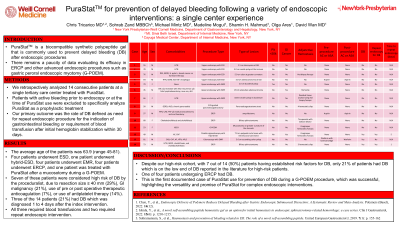Tuesday Poster Session
Category: GI Bleeding
P3455 - Purastat for Prevention of Delayed Bleeding Following a Variety of Endoscopic Interventions: A Single Center Experience
Tuesday, October 24, 2023
10:30 AM - 4:00 PM PT
Location: Exhibit Hall

Has Audio

Christopher J. Tricarico, MD
Weill Cornell Medical Center/New York Presbyterian Hospital
New York, NY
Presenting Author(s)
Christopher J. Tricarico, MD1, Sohrab Zand, MBBCh2, Michael Mintz, MD3, Madeleine Mogl, 4, Shamin H. Mahmud, 5, Olga Ares, BS, MD6, David Wan, BS, MD3
1Weill Cornell Medical Center/New York Presbyterian Hospital, New York, NY; 2Cayuga Medical Center, Ithaca, NY; 3Weill Cornell Medicine, New York, NY; 4Technical University of Munich School of Medicine, Munich, Bayern, Germany; 5Weill Cornell Medicine-Qatar, Doha, Ar Rayyan, Qatar; 6Universidad Francisco de Vitoria, Majadahonda, Madrid, Spain
Introduction: Purastat is a biocompatible synthetic polypeptide gel that is commonly used to prevent delayed bleeding (DB) after endoscopic procedures such as endoscopic mucosal resection (EMR) or endoscopic submucosal dissection (ESD). However, there remains a paucity of data evaluating its efficacy in ERCP and other advanced endoscopic procedures such as gastric peroral endoscopic myotomy (G-POEM), where its ease of deployment across uneven surfaces and ability to maintain visualization of the bleeding site may offer significant advantages over other hemostatic methods.
Methods: We retrospectively analyzed consecutive patients at a single tertiary care center treated with Purastat. Patients with active bleeding prior to endoscopy or at the time of Purastat use were excluded to specifically analyze Purastat as a prophylactic treatment. Our primary outcome was the rate of DB.
Results: Fourteen patients met the inclusion criteria (table 1). The average age of the patients was 63.9 years (range 45-81). Four patients underwent ESD, one patient underwent hybrid-ESD, four patients underwent EMR, four patients underwent ERCP, and one patient was treated with Purastat after a mucosotomy during a G-POEM. Seven of these patients were considered high risk of DB by the proceduralist, due to resection size ≥ 40 mm (29%), GI malignancy (21%), use of pre or post operative therapeutic anticoagulation (7%), or use of antiplatelet therapy (14%). DB was defined as need for repeat endoscopic procedure for the indication of gastrointestinal bleeding or requirement of blood transfusion after initial hemoglobin stabilization within 30 days. Three of the 14 patients (21%) had DB which was diagnosed 1 to 4 days after the index intervention. All three required blood transfusions and two required repeat endoscopic intervention.
Discussion: Despite our high-risk cohort, with 7 out of 14 (50%) patients having established risk factors for DB, only 21% of patients had DB. This is on the low end of DB reported in the literature for high-risk patients. We also included 4 patients that underwent ERCP with various methods of sphincterotomy, one of which had DB. This is also the first documented case of Purastat use for prevention of DB during a G-POEM procedure, which was successful, highlighting the versatility and promise of Purastat for complex endoscopic interventions. Limitations to this study include our small sample size and lack of control group comparing it to conventional hemostatic methods in a similar patient population.
Disclosures:
Christopher J. Tricarico, MD1, Sohrab Zand, MBBCh2, Michael Mintz, MD3, Madeleine Mogl, 4, Shamin H. Mahmud, 5, Olga Ares, BS, MD6, David Wan, BS, MD3. P3455 - Purastat for Prevention of Delayed Bleeding Following a Variety of Endoscopic Interventions: A Single Center Experience, ACG 2023 Annual Scientific Meeting Abstracts. Vancouver, BC, Canada: American College of Gastroenterology.
1Weill Cornell Medical Center/New York Presbyterian Hospital, New York, NY; 2Cayuga Medical Center, Ithaca, NY; 3Weill Cornell Medicine, New York, NY; 4Technical University of Munich School of Medicine, Munich, Bayern, Germany; 5Weill Cornell Medicine-Qatar, Doha, Ar Rayyan, Qatar; 6Universidad Francisco de Vitoria, Majadahonda, Madrid, Spain
Introduction: Purastat is a biocompatible synthetic polypeptide gel that is commonly used to prevent delayed bleeding (DB) after endoscopic procedures such as endoscopic mucosal resection (EMR) or endoscopic submucosal dissection (ESD). However, there remains a paucity of data evaluating its efficacy in ERCP and other advanced endoscopic procedures such as gastric peroral endoscopic myotomy (G-POEM), where its ease of deployment across uneven surfaces and ability to maintain visualization of the bleeding site may offer significant advantages over other hemostatic methods.
Methods: We retrospectively analyzed consecutive patients at a single tertiary care center treated with Purastat. Patients with active bleeding prior to endoscopy or at the time of Purastat use were excluded to specifically analyze Purastat as a prophylactic treatment. Our primary outcome was the rate of DB.
Results: Fourteen patients met the inclusion criteria (table 1). The average age of the patients was 63.9 years (range 45-81). Four patients underwent ESD, one patient underwent hybrid-ESD, four patients underwent EMR, four patients underwent ERCP, and one patient was treated with Purastat after a mucosotomy during a G-POEM. Seven of these patients were considered high risk of DB by the proceduralist, due to resection size ≥ 40 mm (29%), GI malignancy (21%), use of pre or post operative therapeutic anticoagulation (7%), or use of antiplatelet therapy (14%). DB was defined as need for repeat endoscopic procedure for the indication of gastrointestinal bleeding or requirement of blood transfusion after initial hemoglobin stabilization within 30 days. Three of the 14 patients (21%) had DB which was diagnosed 1 to 4 days after the index intervention. All three required blood transfusions and two required repeat endoscopic intervention.
Discussion: Despite our high-risk cohort, with 7 out of 14 (50%) patients having established risk factors for DB, only 21% of patients had DB. This is on the low end of DB reported in the literature for high-risk patients. We also included 4 patients that underwent ERCP with various methods of sphincterotomy, one of which had DB. This is also the first documented case of Purastat use for prevention of DB during a G-POEM procedure, which was successful, highlighting the versatility and promise of Purastat for complex endoscopic interventions. Limitations to this study include our small sample size and lack of control group comparing it to conventional hemostatic methods in a similar patient population.
Disclosures:
Christopher Tricarico indicated no relevant financial relationships.
Sohrab Zand indicated no relevant financial relationships.
Michael Mintz indicated no relevant financial relationships.
Madeleine Mogl indicated no relevant financial relationships.
Shamin Mahmud indicated no relevant financial relationships.
Olga Ares indicated no relevant financial relationships.
David Wan indicated no relevant financial relationships.
Christopher J. Tricarico, MD1, Sohrab Zand, MBBCh2, Michael Mintz, MD3, Madeleine Mogl, 4, Shamin H. Mahmud, 5, Olga Ares, BS, MD6, David Wan, BS, MD3. P3455 - Purastat for Prevention of Delayed Bleeding Following a Variety of Endoscopic Interventions: A Single Center Experience, ACG 2023 Annual Scientific Meeting Abstracts. Vancouver, BC, Canada: American College of Gastroenterology.

